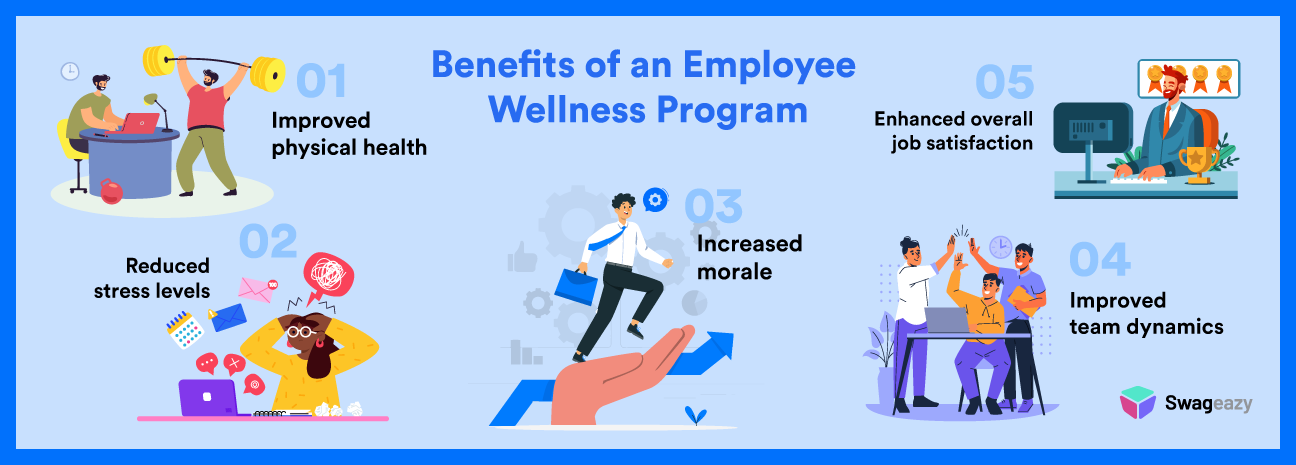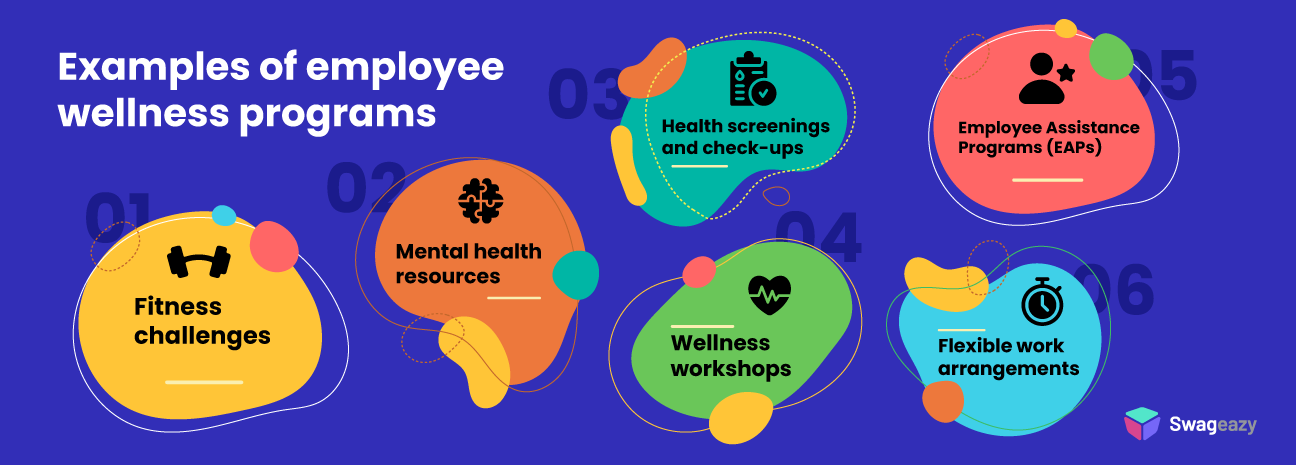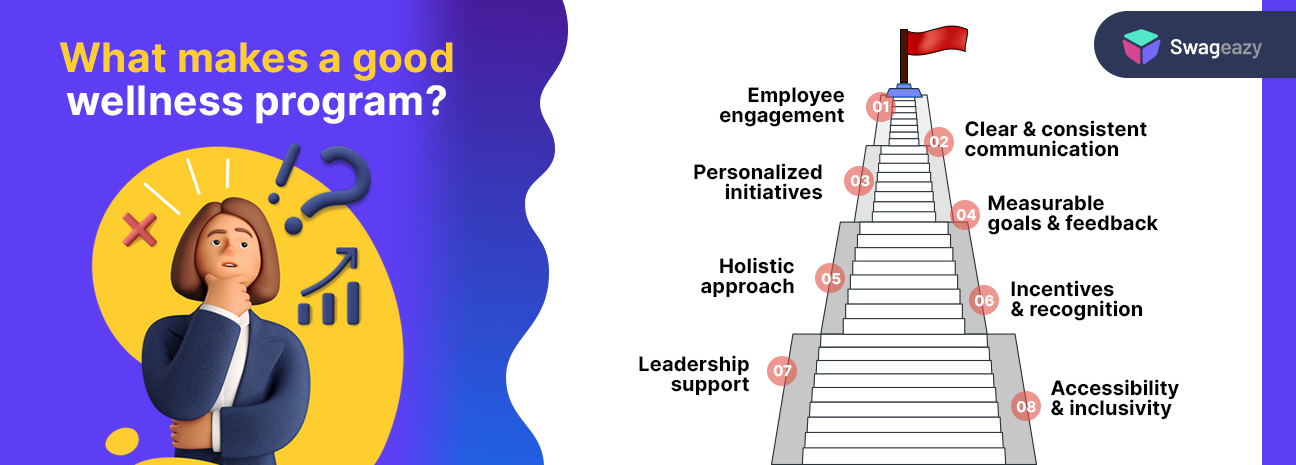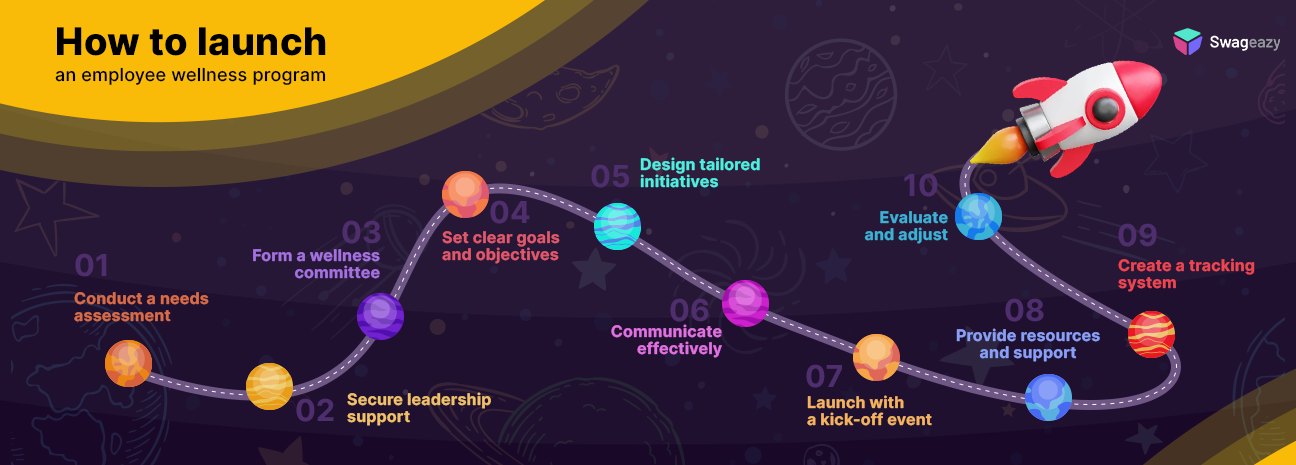How To Create A Successful Employee Wellness Program

Work can be pretty full-on these days, right? With tight deadlines and high expectations, it's no wonder that companies are starting to pay serious attention to how their employees are doing.
As the landscape of work evolves, so does the understanding that a healthy and engaged workforce is not just a desirable aspiration but a strategic necessity.
This is where Employee Wellness Programs come in as a strategy that companies use to make sure their team feels good, both mentally and physically.
But what exactly is an employee wellness program, and why is everyone talking about it? In this blog, we're going to dig into the details.
We'll discuss why looking after employee well-being is a big deal nowadays, the cool perks these programs bring, and what makes a wellness program really work. We'll even throw in some real-life examples to make things more relatable.
In a world where the line between personal and professional lives blurs, the concept of employee wellness has emerged as a guiding light, fostering healthier, happier, and more productive workplaces.
With all that said, let’s jump right in!
What is an employee wellness program?
An Employee Wellness Program is like a playbook for companies aiming to keep their team members happy, healthy, and thriving. It's not just about the usual health benefits – it's a holistic approach that covers everything from physical fitness to mental well-being.
These programs often include things like gym memberships, stress management workshops, and initiatives promoting work-life balance. They're a way for companies to say, "We care about you," by investing in resources that help employees stay at their best, both at work and in life.
One common misconception is that wellness means only physical health. Companies are starting to recognize that it's not just about the occasional yoga class; it's a thoughtful strategy to make the workplace a better, healthier space for everyone.
They are now ready to acknowledge that well-being extends beyond the physical to include mental and emotional aspects.
Importance of employee wellness programs today
With constant deadlines, high expectations, and the ever-present digital demands, the workplace has become a pressure cooker for many. Stress and burnout are real challenges affecting productivity and job satisfaction.
The rise of remote work, though offering flexibility, has blurred the lines between personal and professional life, creating new challenges in maintaining a healthy work-life balance.
Moreover, as awareness around mental health grows, companies are realizing the impact it has on overall well-being and performance. The stigma surrounding mental health is gradually lifting, and organizations are acknowledging the need to address it proactively.
Employee turnover and recruitment costs are additional factors driving the focus on wellness; retaining talent is as crucial as attracting it.
In this landscape, Employee Wellness Programs are a strategic response that not only addresses physical health concerns but also provides tools to navigate the stressors of modern work life.
By fostering a supportive and health-conscious culture, these programs aim to tackle challenges head-on, ensuring employees are not just surviving but thriving in the contemporary workplace.
Benefits of an employee wellness program
Employee Wellness Programs are more than just a corporate trend; they're a game-changer for both employers and employees.
Let's unpack five key benefits that make these programs invaluable in today's dynamic work environment.

1. Improved physical health
The first and most apparent perk is the positive impact on physical health. Wellness programs often offer gym memberships, fitness challenges, and health screenings, encouraging employees to adopt healthier lifestyles.
This not only lowers the risk of chronic illnesses but also boosts energy levels, creating a workforce that's more resilient and less prone to absenteeism.
2. Reduced stress levels
In the pressure cooker of modern work, stress is a constant companion. Employee Wellness Programs provide stress management tools and resources, from mindfulness sessions to workshops on work-life balance.
By addressing stress head-on, these programs contribute to a more focused and composed workforce, ultimately enhancing productivity.
3. Increased morale
When companies invest in the well-being of their employees, it sends a powerful message – "We value you."
This recognition contributes to a positive company culture, fostering a sense of belonging and loyalty among the workforce.
Employees who feel cared for are more likely to be engaged, leading to a significant boost in morale across the organization.
4. Enhanced overall job satisfaction
A happy employee is a productive employee. Wellness programs go beyond the office walls, addressing not only physical health but also mental and emotional well-being.
When employees feel supported in all aspects of their lives, job satisfaction soars. This satisfaction translates into increased loyalty, breduced turnover, and a more positive work environment.
5. Improved team dynamics
Wellness programs often include team-building activities, creating opportunities for employees to interact outside the usual work context.
Whether it's a fitness challenge or a wellness workshop, these shared experiences foster camaraderie and strengthen team bonds.
A cohesive team is more collaborative and resilient, contributing to a healthier organizational culture.
The benefits of corporate wellness programs extend far beyond the individual, creating a ripple effect that positively influences the entire organizational ecosystem.
Examples of employee wellness programs
Now that we've explored the benefits, let's dive into the real-world applications of Employee Wellness Programs. These initiatives come in various shapes and sizes, tailored to meet the diverse needs of employees.
Here are six examples that showcase the versatility and impact of wellness programs.

1. Fitness challenges
Transform the workplace into a hub of physical activity by organizing fitness challenges. Whether it's a step competition, a monthly fitness goal, or a team sports event, these challenges not only promote physical health but also foster a sense of friendly competition and camaraderie among employees.
2. Mental health resources
Prioritize mental well-being by providing resources such as counseling services, stress management workshops, and mindfulness sessions. By openly addressing mental health concerns, employees feel supported, contributing to a healthier and more resilient workforce.
3. Wellness workshops and seminars
Empower employees with knowledge about holistic well-being through wellness workshops. Cover topics like nutrition, sleep hygiene, financial health, and stress reduction techniques, to name a few.
These educational sessions equip employees with practical tools for leading healthier lifestyles.
4. Flexible work arrangements
Recognize the importance of work-life balance by offering flexible work arrangements. This could include flexible hours, telecommuting options, or compressed workweeks.
Providing flexibility helps employees better manage their personal and professional responsibilities, reducing stress and enhancing overall well-being.
5. Health screenings and check-ups
Take a proactive approach to employee health with on-site health screenings and check-ups. Regular screenings for blood pressure, cholesterol, and vaccinations can aid in early detection and preventive care, contributing to long-term well-being.
6. Employee Assistance Programs (EAPs)
Implement Employee Assistance Programs to offer confidential support for employees facing personal challenges. EAPs can provide counseling services, financial guidance, and legal assistance, creating a safety net for employees dealing with various life situations.
While this list is not a definitive list of programs you can implement, these examples illustrate the diverse strategies that organizations can employ to promote employee wellness.
By tailoring programs to address both physical and mental health, companies can create a workplace culture that prioritizes the overall well-being of their valuable asset – their employees.
What makes a good wellness program?
Creating an effective Employee Wellness Program goes beyond offering a checklist of benefits. It's about cultivating a culture of well-being that resonates with employees.
Here are key characteristics that contribute to the success of a wellness program.

- Employee engagement: A good wellness program actively involves employees. Engaging activities, such as workshops, challenges, and events, encourage participation. When employees feel invested in the program, it becomes a shared journey toward better health and well-being.
- Personalized initiatives: Recognizing that one size does not fit all, a successful program incorporates personalized initiatives. Tailoring offerings to accommodate diverse interests and needs ensures that employees feel supported in their individual wellness journeys.
- Holistic approach: A comprehensive wellness program addresses physical, mental, and emotional well-being. It goes beyond fitness challenges to include resources for stress management, mental health support, and nutritional guidance. Holistic programs acknowledge that well-being is multifaceted.
- Leadership support: Strong support from leadership is a linchpin for the success of any wellness program. When leaders actively promote and participate in wellness initiatives, it sets a powerful example, signaling to the entire organization that well-being is a top priority.
- Clear communication: Communication is key to the success of a wellness program. Clear and consistent messaging about program offerings, goals, and the benefits of participation fosters understanding and enthusiasm among employees.
- Measurable goals and feedback: A successful program sets clear, achievable goals and provides mechanisms for tracking progress. Regular feedback, whether through assessments or surveys, allows for continuous improvement and ensures that the program remains aligned with the evolving needs of the workforce.
- Incentives and recognition: Incentives and recognition mechanisms motivate employees to actively participate. Whether through rewards for achievements or acknowledgment of milestones, these elements contribute to a positive and encouraging program environment.
- Accessibility and inclusivity: A good wellness program is accessible to all employees. This includes considerations for remote workers and those with varying abilities. An inclusive approach ensures that everyone can benefit from the program, promoting a sense of unity and equity.
How to launch an employee wellness program
Embarking on the journey of introducing an employee wellness program is not just about ticking boxes; it's about fostering a culture of well-being that resonates with your workforce.
It’s important to understand that launching an employee wellness program is not a one-time event but an ongoing commitment to the well-being of your employees.
Let’s walk through the essential steps to successfully launch a program that not only meets the needs of your employees but also cultivates a healthier and more engaged workplace.

Step 1 - Conduct a needs assessment
Start by engaging with your employees to understand their well-being needs. Conduct surveys, hold focus group sessions, and analyze existing data to identify the specific areas that matter most to your workforce.
This collaborative approach ensures that the wellness program is tailored to the unique needs of your organization.
Step 2 - Secure leadership support
Present a compelling case to top leadership about the benefits of a wellness program. Clearly articulate how it aligns with organizational goals, enhances employee engagement, and contributes to a positive workplace culture.
Active leadership support is not just a checkbox but a catalyst for program success.
Step 3 - Form a wellness committee
Establish a diverse wellness committee with representatives from different departments. This committee becomes the driving force behind the program, bringing varied perspectives to the table.
Regular meetings and collaboration ensure that the program is well-rounded and inclusive.
Step 4 - Set clear goals and objectives
Define specific, measurable, and achievable goals for your wellness program. For instance, if stress reduction is a goal, set a target percentage decrease and a timeframe for achieving it.
Clearly defined objectives provide a roadmap for success and help measure the impact of the program.
Step 5 - Design tailored initiatives
Develop a range of wellness initiatives that cater to the identified needs of your workforce. Consider physical activities, mental health resources, and educational workshops.
Personalize initiatives based on employee preferences to enhance engagement. For instance, if a significant number of employees express interest in yoga, incorporate yoga sessions into the program.
Step 6 - Communicate effectively
Craft a comprehensive communication plan to ensure that employees are well-informed about the program.
Utilize multiple channels such as email, company intranet, posters, and team meetings to effectively communicate the program's goals, initiatives, and the benefits of participation.
Step 7 - Launch with a kick-off event
How: Generate excitement by launching the program with a kick-off event. Consider hosting a wellness fair, inviting a keynote speaker, or organizing a team-building activity. The kick-off event sets a positive and energizing tone for the entire program, creating enthusiasm among participants.
Step 8 - Provide resources and support
Ensure that employees have easy access to the resources and support needed to participate in the wellness program.
This may involve providing necessary equipment, creating dedicated spaces for wellness activities, and offering guidance on how to integrate program elements into daily routines.
Step 9 - Create a tracking system
Implement a tracking system to monitor and evaluate the progress of the wellness program. Track participation rates, gather survey feedback, and measure any tangible outcomes.
Use this data to identify trends, recognize areas of success, and make informed adjustments to enhance the program's effectiveness.
Step 10 - Evaluate and adjust
Regularly assess the effectiveness of the program against the established goals. Collect feedback from participants through surveys or focus groups, and analyze the overall impact on employee well-being.
Use this information to make data-driven adjustments, ensuring that the program evolves in response to the changing needs of your workforce.
Best practices when setting up an employee wellness program
Let's take a quick look at five best practices to guide you in creating a program that resonates with your workforce and cultivates a culture of well-being.

1. Emphasize measurement and impact assessment
Prioritize the measurement of the program's impact. Establish key performance indicators (KPIs) and regularly assess progress against these benchmarks.
Analyzing the tangible outcomes allows for continuous improvement and ensures the program remains aligned with organizational goals.
2. Integrate wellness into company policies
Extend the commitment to wellness beyond the program by integrating well-being principles into company policies. Consider policies that support flexible work arrangements, mental health days, or initiatives promoting a healthy work-life balance.
This ensures a holistic and sustained approach to employee well-being.
3. Cultivate a culture of recognition
Implement a system for recognizing and celebrating employee achievements within the wellness program.
This could involve acknowledging milestones, participation levels, or positive changes in well-being. Recognition fosters a positive atmosphere and encourages continued engagement.
4. Facilitate peer support networks
Encourage the formation of peer support networks within the workplace. These networks can provide a platform for employees to share experiences, challenges, and successes related to wellness.
Creating a sense of community fosters mutual support and enhances the overall impact of the program.
5. Offer continuous learning opportunities
Promote a culture of continuous learning by providing ongoing opportunities for employees to enhance their well-being knowledge.
This could involve regular workshops, webinars, or access to resources that empower employees to take charge of their health and wellness journey.
To wrap up,
At a time when professional and personal lines often blur, investing in the health and happiness of employees has become a crucial imperative.
Successful wellness programs extend beyond physical health, recognizing the multifaceted nature of well-being that encompasses mental and emotional aspects. It's a commitment to fostering a supportive culture where employees thrive both professionally and personally.
As you embark on or enhance your journey toward employee well-being, remember that the true impact of a wellness program lies in the positive transformations it cultivates—in the lives of individual employees, in the dynamics of teams, and in the overall workplace culture.
Embrace the principles of inclusivity, engagement, and continuous improvement. Wellness is not a destination but a continuous journey, and by weaving it into the fabric of your organization, you're not just investing in the present but also shaping a healthier future.
Your thoughts and experiences are invaluable in this ongoing conversation. Share your insights, questions, and success stories.
If you enjoyed reading this and want to learn more about how to cultivate a positive workplace that encourages growth, check out our Swageazy blog.
Until next time!